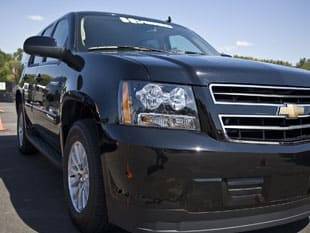First Drive: 2008 Chevrolet Tahoe 2-Mode Hybrid (and GMC Yukon, too)


The Chevrolet Tahoe 2-Mode Hybrid is GM’s first full parallel hybrid — meaning the hybrid system can propel the vehicle with an electric motor, a gasoline engine or a combination of the two. That’s the setup that gives many of today’s most efficient hybrids their mileage gains. After driving it and its full-size sister SUV, the GMC Yukon Hybrid — and after grilling GM’s execs — there don’t appear to be any significant tradeoffs compared to a regular model. That said, the gas mileage is now described only as “up to 25 percent better” than the non-hybrid in mixed driving and up to 40 percent better in the city. That would mean gas mileage around 19.6 mpg in city driving, while the mixed-driving estimate could be as high as 20 mpg. EPA numbers will be released closer to the on-sale date in the fourth quarter of 2007.
The Tahoe may feel even more natural than some other hybrids because it combines fixed transmission gears with the continuously variable nature of a full hybrid. In other words, it shifts just like an automatic transmission, but with some continuously variable changes, too. It moves much like a regular Tahoe — and quickly. 2-Mode combines GM’s 6.0-liter V-8 engine with the added oomph of electric motors. Six liters might sound large for a hybrid, but the engine can deactivate four of its cylinders when under light load. Could GM have made the trucks less strong/quick and more efficient? Most likely, and environmentalists are sure to object, but boaters are likely to celebrate.
The 2-Mode name is interesting, but it doesn’t seem to have any modes the other major players don’t. 2-Mode is almost identical to what’s under the hood of, say, the Toyota Prius, Camry Hybrid and the Ford Escape Hybrid. The main differences are that 2-Mode packs all that stuff into a transmission case and retains a four-speed automatic. The most noticeable sign that the truck was a hybrid came from the braking; there’s a telltale feel in the pedal when you press it because it’s activating regenerative braking, where the motor/generators use the vehicle’s momentum to recharge the battery pack. It takes some acclimation, but this is among the less conspicuous hybrids I’ve braked.
In addition to that, you also get what the other hybrids have. The engine turns itself off and on when you stop, and there was even a power-flow diagram on the dashboard’s LCD screen and some supplemental gauges in the instrument panel. The Tahoe and Yukon are the first hybrids to seat as many as nine people, and you can get two- or four-wheel drive. You give up a few things — like a power liftgate and power-release second-row seats — because they add weight, which hurts efficiency. These trucks are slightly heavier than the non-hybrids, but that’s after extensive steps to shave weight. The hood, liftgate and some suspension parts are made of lightweight aluminum rather than steel, the wheels and low-rolling-resistance tires are lighter, and the seats are lighter and thinner, which preserves backseat headroom and legroom even though the battery pack is stored in the floor.
The gas tank is smaller and, thus, lighter, but Chevy says the higher efficiency means the truck’s range is the same or a bit greater. It seems like they thought of everything. You lose some maximum payload capacity: roughly 400 pounds, for a 1,426-pound maximum with rear-wheel drive. Trailering capacity comes down 1,300 pounds to 6,200 pounds maximum (2WD) and 2,200 pounds to 6,000 pounds (4WD). GM says the drop isn’t because the drivetrain is too weak, it’s because the model’s aerodynamic nose treatment won’t admit enough cooling air for a heavier load.
GM execs suggest the hybrid won’t exceed the price of either model’s most-loaded non-hybrid trim level, which is just shy of $40,000 for a Tahoe LTZ 4WD and $49,420 for a Yukon Denali AWD, including destination charges. Whether you consider the sticker price reasonable or not, the tradeoff here is the manufacturer’s. A GM vice president said each 2-Mode system costs the automaker about $10,000, and that doesn’t include the cost of all those lightweight components and aerodynamic treatments to the nose, undercarriage and rearmost pillars. GM isn’t the only company to subsidize — or lose their shirt on — each hybrid sold. The choice of a full-size SUV as their first full hybrid makes sense; it’s the vehicle type that needs it the most, and its profit margin is great enough to absorb some of the outrageous technology costs.
Related
More Hybrid News (KickingTires)
First Drive: 2008 Chevrolet Corvette (KickingTires)
First Drive: 2008 Saab 9-3, Saab 9-7X Aero (KickingTires)
First Drive: 2008 Pontiac Torrent GXP, 2008 Buick LaCrosse Super (KickingTires)

Former Executive Editor Joe Wiesenfelder, a Cars.com launch veteran, led the car evaluation effort. He owns a 1984 Mercedes 300D and a 2002 Mazda Miata SE.
Featured stories




